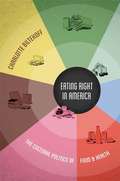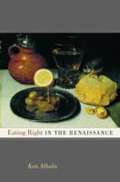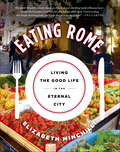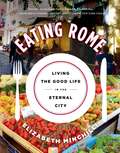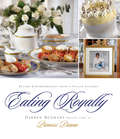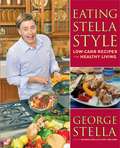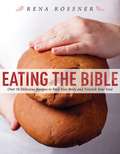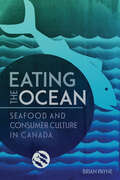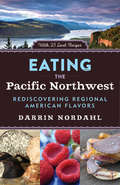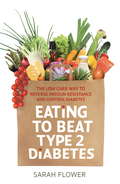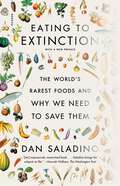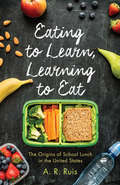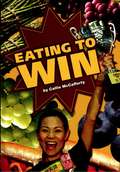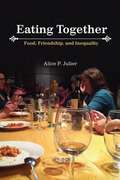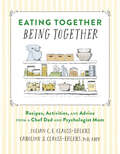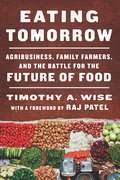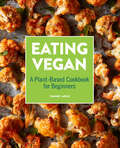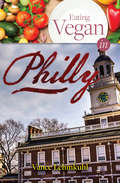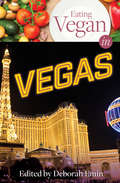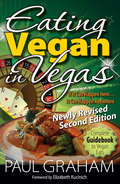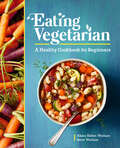- Table View
- List View
Eating Right in America: The Cultural Politics of Food and Health
by Charlotte BiltekoffEating Right in America is a powerful critique of dietary reform in the United States from the late nineteenth-century emergence of nutritional science through the contemporary alternative food movement and campaign against obesity. Charlotte Biltekoff analyzes the discourses of dietary reform, including the writings of reformers, as well as the materials they created to bring their messages to the public. She shows that while the primary aim may be to improve health, the process of teaching people to "eat right" in the U.S. inevitably involves shaping certain kinds of subjects and citizens, and shoring up the identity and social boundaries of the ever-threatened American middle class. Without discounting the pleasures of food or the value of wellness, Biltekoff advocates a critical reappraisal of our obsession with diet as a proxy for health. Based on her understanding of the history of dietary reform, she argues that talk about "eating right" in America too often obscures structural and environmental stresses and constraints, while naturalizing the dubious redefinition of health as an individual responsibility and imperative.
Eating Right in the Renaissance
by Ken AlbalaEating right has been an obsession for longer than we think. Renaissance Europe had its own flourishing tradition of dietary advice. Then, as now, an industry of experts churned out diet books for an eager and concerned public.
Eating Rome: Living the Good Life in the Eternal City
by Elizabeth Minchilli“Minchilli unlocks the secret door to reveal a thrilling world of Roman food—not just the best places to go but also why Italians adore them.” —Ina GartenElizabeth Minchilli has been eating her way through Rome since she was 12 years old. Eating Rome, based on her popular blog Elizabeth Minchilli in Rome, is her homage to the city that feeds her, literally and figuratively. Her story is a personal, quirky and deliciously entertaining look at some of the city’s monuments to food culture. Join her as she takes you on a stroll through her favorite open-air markets; stop by the best gelato shops; order plates full of carbonara and finish the day with a brilliant red Negroni. Coffee, pizza, artichokes and grappa are starting points for mouth-watering stories about this ancient city. Illustrated with Minchilli’s beautiful full-color photos and enriched with her favorite recipes for Roman classics like vignarola, carciofi alla romana and carbonara, Eating Rome is the book that you want if you are planning your first trip to Rome or if you have been to Rome a dozen times. And even if you just want to spend a few hours armchair traveling, Elizabeth Minchilli is the person you want by your side.“You’ll find this book a handy navigator whether in Rome for two days or two months, and a delicious gift for someone who is embarking on a trip to Italy, especially if it is their first.” —The Wall Street Journal“A truly insider’s culinary guide to Rome, Elizabeth Minchilli takes us into the trattorias, caffès, pizzerias, and gelaterias of Rome.” —David Lebovitz, New York Times–bestselling author of The Sweet Life in Paris
Eating Rome: Living the Good Life in the Eternal City
by Elizabeth Helman MinchilliElizabeth Minchilli has been eating her way through Rome since she was 12 years old. Eating Rome, based on her popular blog Elizabeth Minchilli in Rome, is her homage to the city that feeds her, literally and figuratively. Her story is a personal, quirky and deliciously entertaining look at some of the city's monuments to food culture. Join her as she takes you on a stroll through her favorite open air markets; stop by the best gelato shops; order plates full of carbonara and finish the day with a brilliant red Negroni. Coffee, pizza, artichokes and grappa are starting points for mouth-watering stories about this ancient city. Illustrated with Minchilli's beautiful full-color photos and enriched with her favorite recipes for Roman classics like vignarola, carciofi alla romana and carbonara, Eating Rome is the book that you want if you are planning your first trip to Rome or if you have been to Rome a dozen times. And even if you just want to spend a few hours armchair traveling, Elizabeth Minchilli is the person you want by your side.
Eating Royally
by Darren McgradyMeals and memories from Princess Diana's personal chef. All families have their favorite foods?including the House of Windsor. Darren McGrady, personal chef to Princess Diana and chef to the royal family for fifteen years, has collected more than 100 recipes in Eating Royally and behind-the-scenes stories that offer insight into the royal family's lives. From hearty cooking to gourmet eating, these dishes will impress even the most discerning palates. Recipes include traditional English fare, and, of course, royal favorites, such as: Spring Asparagus Soup with Dill Poached Eggs en Croute Gleneagles Pate Earl Grey Tea Cake Gaelic Steaks Royal Tea Scones Eggs Drumkilbo Summer Pudding Iced Praline Souffles McGrady witnessed the rich history and surprisingly normal family life of the Royals, all while preparing elegant food with classical French influences for their table. Filled with touching photographs, mementos, and personal messages, Eating Royally chronicles one chef's extraordinary experiences within the walls of Buckingham Palace.
Eating Royally
by Darren McgradyMeals and memories from Princess Diana's personal chef.All families have their favorite foods?including the House of Windsor. Darren McGrady, personal chef to Princess Diana and chef to the royal family for fifteen years, has collected more than 100 recipes in Eating Royally and behind-the-scenes stories that offer insight into the royal family's lives.From hearty cooking to gourmet eating, these dishes will impress even the most discerning palates. Recipes include traditional English fare, and, of course, royal favorites, such as:Spring Asparagus Soup with DillPoached Eggs en CrouteGleneagles PateEarl Grey Tea CakeGaelic SteaksRoyal Tea SconesEggs DrumkilboSummer PuddingIced Praline SoufflesMcGrady witnessed the rich history and surprisingly normal family life of the Royals, all while preparing elegant food with classical French influences for their table.Filled with touching photographs, mementos, and personal messages, Eating Royally chronicles one chef's extraordinary experiences within the walls of Buckingham Palace.
Eating Stella Style: Low-Carb Recipes for Healthy Living
by George Stella Christian StellaProfessional chef George Stella serves up a feast of inspiration and 125 delicious recipes to kick-start any weight-loss plan! George Stella lost more than 250 pounds on a low-carb eating plan and has turned thousands of fans on to Stella Style -- eating fresh, natural foods prepared with minimum effort for maximum taste. In Eating Stella Style, he shows readers how to tailor his recipes to fit any personalized weight-loss plan, whether it's low carb, low fat, or low calorie. He inspires even the most jaded dieters to begin a new eating lifestyle and shows them how to stay on track. But Eating Stella Style is really about mouthwatering recipes: How does a Hot Ham and Cheese Egg Roll sound for breakfast? Or Strawberry and Mascarpone Cream Crêpes, Stella Style Baked Eggs Benedict, or Coconut Macaroon Muffins? For lunch or dinner, choose Grilled Portabella and Montrachet Salad, Wood-Grilled Oysters with Dill Butter, Kim's Stuffed Chicken Breasts with Lemony White Wine Sauce, Shaved Zucchini Parmesan Salad, or Spaghetti Squash with Clams Provençal Sauce. Satisfy your snack cravings with Better Cheddar Cheese Crisps, Devilish Deviled Eggs with Tuna, or Cheesy Pecan Cookies. And for dessert, try Pumpkin Pound Cake, Lemon Meringue Pie, Honeydew and Blackberry Granita, or Chocolate Pecan Truffles. Perfect for both devoted Stella Style fans and new converts, Eating Stella Style will tempt you with tasty, flexible recipes that satisfy everyone!
Eating Stella Style
by George Stella Christian StellaProfessional chef George Stella serves up a feast of inspiration and 125 delicious recipes to kick-start any weight-loss plan! George Stella lost more than 250 pounds on a low-carb eating plan and has turned thousands of fans on to Stella Style -- eating fresh, natural foods prepared with minimum effort for maximum taste. In Eating Stella Style, he shows readers how to tailor his recipes to fit any personalized weight-loss plan, whether it's low carb, low fat, or low calorie. He inspires even the most jaded dieters to begin a new eating lifestyle and shows them how to stay on track. But Eating Stella Style is really about mouthwatering recipes: How does a Hot Ham and Cheese Egg Roll sound for breakfast? Or Strawberry and Mascarpone Cream Crêpes, Stella Style Baked Eggs Benedict, or Coconut Macaroon Muffins? For lunch or dinner, choose Grilled Portabella and Montrachet Salad, Wood-Grilled Oysters with Dill Butter, Kim's Stuffed Chicken Breasts with Lemony White Wine Sauce, Shaved Zucchini Parmesan Salad, or Spaghetti Squash with Clams Provençal Sauce. Satisfy your snack cravings with Better Cheddar Cheese Crisps, Devilish Deviled Eggs with Tuna, or Cheesy Pecan Cookies. And for dessert, try Pumpkin Pound Cake, Lemon Meringue Pie, Honeydew and Blackberry Granita, or Chocolate Pecan Truffles. Perfect for both devoted Stella Style fans and new converts, Eating Stella Style will tempt you with tasty, flexible recipes that satisfy everyone!
Eating the Alphabet: Fruits & Vegetables from A to Z
by Lois EhlertA vibrant and sturdy word book starring fruits and vegetables from around the world from Caldecott Honor–winning author-illustrator Lois Ehlert. Features upper- and lowercase letters for preschoolers just learning language.Each turn of the page reveals a mouth-watering arrangement of foods: Indian corn, jalapeno, jicama, kumquat, kiwifruit and kohlrabi. Lois Ehlert's lively watercolors paired with bold easy-to-read type make for a highly appealing and accessible book for parents and children to devour.At the end of the book, Ehlert provides a detailed glossary that includes pronunciation, botanical information, the origin and history of the particular plant and occasional mythological references, with a small watercolor picture to remind the reader of what the plant looks like.Apple to Zucchini,come take a look.Start eating your waythrough this alphabet book.
Eating the Bible: Over 50 Delicious Recipes to Feed Your Body and Nourish Your Soul
by Rena RossnerOne weekend, a decade ago, author Rena Rossner was served a bowl of lentil soup at dinner. The portion of the Bible that had been discussed that week was the chapter in which Esau sells his birthright to his brother Jacob for a bowl of red lentil soup. Rossner was struck by the ability to bring the Bible alive in such a tactile way and decided on the spot to see whether she could incorporate the Bible into a meal each week. And so she has. The result, Eating the Bible, is an innovative cookbook with original, easy-to-prepare recipes that will ignite table conversation while pleasing the stomach. Every meal will become both a tactile and intellectual experience as the recipes enrich both the soul of the cook and the palates of those at the table.Every cook must glance at a recipe countless times before completing a dish. Often recipes involve five- to ten-minute periods during which one must wait for the water to boil, the soup to simmer, or the onions to sauté. It is Rossner's goal to help enrich those moments with biblical verse and commentary, to enable cooks to feed their souls as they work to feed the members of the household and guests. From the zesty "Garden of Eden Salad" to the "Honey Coriander Manna Bread," each recipe will delight the palate and spark the mind.
Eating the Ocean: Seafood and Consumer Culture in Canada (La collection Louis J. Robichaud/The Louis J. Robichaud Series)
by Brian PayneDuring the first half of the twentieth century, Canadian fisheries regularly produced more fish than markets could absorb, driving down profits and wages. To address this, both industry and government sought to stimulate domestic consumption via increased advertising. In Eating the Ocean Brian Payne explores how government-funded marketing called upon Canadian housewives to prepare more seafood meals to improve family health and aid an industry central to Canadian identity and heritage. The goal was first to make seafood a central element of a “wholesome” diet as a solution to a perceived nutritional crisis, and, second, to aid industry recovery and growth while decreasing Canadian fisheries’ dependency on foreign markets. But fishery managers and policymakers fundamentally miscalculated consumer demand, wrongly assuming that Canadians could and would eat more seafood. Fisheries continued to extract more fish than the environment and the market could sustain, and the collapse of the nation’s fisheries that we are now seeing has as much to do with failed assessments of market demand as it does with faulty extraction practices. Using internal communications between industry leaders and Ottawa bureaucrats, as well as advertising and promotional material published in the nation’s leading magazines, national and local newspapers, and radio programming, Eating the Ocean traces the flawed understanding of not only supply but demand, a misguided gamble that caused fisheries to become the most mismanaged resource economy in early-twentieth-century Canada.
Eating the Pacific Northwest: Rediscovering Regional American Flavors
by Darrin NordahlFrom the brisk waters of Seattle to the earthy mushroom-studded forest surrounding Portland, author Darrin Nordahl takes us on a journey to expand our palates with the local flavors of the beautiful Pacific Northwest. There are a multitude of indigenous fruits, vegetables, mushrooms, and seafood waiting to be rediscovered in the luscious PNW. Eating the Pacific Northwest looks at the unique foods that are native to the region including salmon, truffles, and of course, geoduck, among others. Festivals featured include the Oregon Truffle Festival and Dungeness Crab and Seafood Festival, and there are recipes for every ingredient, including Buttermilk Fried Oysters with Truffled Rémoulade and Nootka Roses and Salmonberries. Nordahl also discusses some of the larger agricultural, political, and ecological issues that prevent these wild, and arguably tastier foods, from reaching our table.
Eating to Beat Type 2 Diabetes: The low carb way to reverse insulin resistance and control diabetes
by Sarah FlowerIn Eating to Beat Type 2 Diabetes, qualified nutritionist and esteemed author Sarah Flower offers a key message for those who either have or are at risk of developing type 2 diabetes: avoid processed grains, sugars and other foods, and opt instead for a balanced diet containing proper ingredients that are rich in natural fats and good-quality protein. Sarah put her own clients suffering from type 2 diabetes onto this sugar-free, low-carb and high-fat regime with amazing results. They experienced weight loss, increased energy levels and - most importantly - they saw their blood sugar levels decrease to a normal range so that they were able to come off medication. This book: -Explains how to make the essential dietary changes to fight type 2 diabetes and the science behind them -Provides a comprehensive 'go-to' list of good and bad foods -Gives practical, easy-to-follow and utterly delicious family recipes which prove that changing your lifestyle and eating habits doesn't have to mean missing out on foods you love - from 'Easy low-carb pancakes' to 'Grain-free chicken Kiev' Eating to Beat Type 2 Diabetes has been supported by Dr David Unwin and Dr Ian Lake. In 2016 Dr Unwin was both 'NHS Innovator of the year' and a finalist for 'Diabetes Team of the Year' in the British Medical Journal National Awards. Dr Ian Lake is medical advisor to diabetes.co.uk and founder member of The Public Health Collaboration, a charity dedicated to informing and implementing health decisions for better public health.
Eating to Beat Type 2 Diabetes: The low carb way to reverse insulin resistance and control diabetes
by Sarah FlowerIn Eating to Beat Type 2 Diabetes, qualified nutritionist and esteemed author Sarah Flower offers a key message for those who either have or are at risk of developing type 2 diabetes: avoid processed grains, sugars and other foods, and opt instead for a balanced diet containing proper ingredients that are rich in natural fats and good-quality protein. Sarah put her own clients suffering from type 2 diabetes onto this sugar-free, low-carb and high-fat regime with amazing results. They experienced weight loss, increased energy levels and - most importantly - they saw their blood sugar levels decrease to a normal range so that they were able to come off medication. This book: -Explains how to make the essential dietary changes to fight type 2 diabetes and the science behind them -Provides a comprehensive 'go-to' list of good and bad foods -Gives practical, easy-to-follow and utterly delicious family recipes which prove that changing your lifestyle and eating habits doesn't have to mean missing out on foods you love - from 'Easy low-carb pancakes' to 'Grain-free chicken Kiev' Eating to Beat Type 2 Diabetes has been supported by Dr David Unwin and Dr Ian Lake. In 2016 Dr Unwin was both 'NHS Innovator of the year' and a finalist for 'Diabetes Team of the Year' in the British Medical Journal National Awards. Dr Ian Lake is medical advisor to diabetes.co.uk and founder member of The Public Health Collaboration, a charity dedicated to informing and implementing health decisions for better public health.
Eating to Extinction: The World's Rarest Foods and Why We Need to Save Them
by Dan SaladinoDan Saladino's Eating to Extinction is the prominent broadcaster’s pathbreaking tour of the world’s vanishing foods and his argument for why they matter now more than everOver the past several decades, globalization has homogenized what we eat, and done so ruthlessly. The numbers are stark: Of the roughly six thousand different plants once consumed by human beings, only nine remain major staples today. Just three of these—rice, wheat, and corn—now provide fifty percent of all our calories. Dig deeper and the trends are more worrisome still:The source of much of the world’s food—seeds—is mostly in the control of just four corporations. Ninety-five percent of milk consumed in the United States comes from a single breed of cow. Half of all the world’s cheese is made with bacteria or enzymes made by one company. And one in four beers drunk around the world is the product of one brewer.If it strikes you that everything is starting to taste the same wherever you are in the world, you’re by no means alone. This matters: when we lose diversity and foods become endangered, we not only risk the loss of traditional foodways, but also of flavors, smells, and textures that may never be experienced again. And the consolidation of our food has other steep costs, including a lack of resilience in the face of climate change, pests, and parasites. Our food monoculture is a threat to our health—and to the planet. In Eating to Extinction, the distinguished BBC food journalist Dan Saladino travels the world to experience and document our most at-risk foods before it’s too late. He tells the fascinating stories of the people who continue to cultivate, forage, hunt, cook, and consume what the rest of us have forgotten or didn’t even know existed. Take honey—not the familiar product sold in plastic bottles, but the wild honey gathered by the Hadza people of East Africa, whose diet consists of eight hundred different plants and animals and who communicate with birds in order to locate bees’ nests. Or consider murnong—once the staple food of Aboriginal Australians, this small root vegetable with the sweet taste of coconut is undergoing a revival after nearly being driven to extinction. And in Sierra Leone, there are just a few surviving stenophylla trees, a plant species now considered crucial to the future of coffee.From an Indigenous American chef refining precolonial recipes to farmers tending Geechee red peas on the Sea Islands of Georgia, the individuals profiled in Eating to Extinction are essential guides to treasured foods that have endured in the face of rampant sameness and standardization. They also provide a roadmap to a food system that is healthier, more robust, and, above all, richer in flavor and meaning.
Eating to Learn, Learning to Eat: The Origins of School Lunch in the United States
by Andrew R. RuisIn Eating to Learn, Learning to Eat, historian A. R. Ruis explores the origins of American school meal initiatives to explain why it was (and, to some extent, has continued to be) so difficult to establish meal programs that satisfy the often competing interests of children, parents, schools, health authorities, politicians, and the food industry. Through careful studies of several key contexts and detailed analysis of the policies and politics that governed the creation of school meal programs, Ruis demonstrates how the early history of school meal program development helps us understand contemporary debates over changes to school lunch policies.
Eating to Win (Fountas & Pinnell LLI Purple #Level P)
by Callie McCaffertyEating to Win by Callie McCafferty
Eating Together: Food, Friendship and Inequality
by Alice P. JulierAn insightful map of the landscape of social meals, Eating Together: Food, Friendship, and Inequality argues that the ways in which Americans eat together play a central role in social life in the United States. Delving into a wide range of research, Alice P. Julier analyzes etiquette and entertaining books from the past century and conducts interviews and observations of dozens of hosts and guests at dinner parties, potlucks, and buffets. She finds that when people invite friends, neighbors, or family members to share meals within their households, social inequalities involving race, economics, and gender reveal themselves in interesting ways: relationships are defined, boundaries of intimacy or distance are set, and people find themselves either excluded or included.
Eating Together, Being Together: Recipes, Activities, and Advice from a Chef Dad and Psychologist Mom
by Julian Clauss-Ehlers Dr. Caroline Clauss-EhlersSilver Winner: Nautilus Award Grand Prize: Chanticleer International Book Award Finalist: American Writing Awards: Cookbooks, Parenting and Family Grow closer as a family through mealtime bonding. Explore more than 80 recipes plus essays, tips, and activities for the whole family that show how cooking together and sharing family meals can help build healthy relationships with food and with each other.With unique insights from a New York Times–starred chef dad and an award-winning psychologist mom, Eating Together, Being Together is much more than a cookbook. It teaches parents and children from toddlerhood through the teen years how to engage around cooking and mealtime. Each chapter offers easy-to-make recipes using fresh ingredients accompanied by thoughts and tips on using mindfulness to deal with picky eating, listening skills, academic stress, and more. This structure allows preparing and eating meals together to be meaningful, where kids and their parents, guardians, and caregivers can learn from one another and grow closer. Recipes include a range of food options to accommodate varying tastes with accessible step-by-step instructions for parents and kids. Activities for each chapter tie in key themes for cooking and for life and are presented in a developmentally thoughtful way for young children, preteens, teens, and grown-ups. From eating mindfulness and having honest food conversations to building rituals that support togetherness, this book explores how the family meal, whether cooking or eating, can bring families closer together. Whether it's kids sharing their feelings while they mix batter, or adults telling stories of their childhood while enjoying a favorite recipe, a special kind of bonding happens around food. Eating Together, Being Together gives you the recipes and activities for that bonding experience and helps set the table for connection.
Eating Tomorrow: Agribusiness, Family Farmers, and the Battle for the Future of Food
by Timothy A. Wise<p>A major new book that shows the world already has the tools to feed itself, without expanding industrial agriculture or adopting genetically modified seeds, from the Small Planet Institute expert <p>Few challenges are more daunting than feeding a global population projected to reach 9.7 billion in 2050--at a time when climate change is making it increasingly difficult to successfully grow crops. In response, corporate and philanthropic leaders have called for major investments in industrial agriculture, including genetically modified seed technologies. Reporting from Africa, Mexico, India, and the United States, Timothy A. Wise's Eating Tomorrow discovers how in country after country agribusiness and its well-heeled philanthropic promoters have hijacked food policies to feed corporate interests. <p>Most of the world, Wise reveals, is fed by hundreds of millions of small-scale farmers, people with few resources and simple tools but a keen understanding of what and how to grow food. These same farmers--who already grow more than 70 percent of the food eaten in developing countries--can show the way forward as the world warms and population increases. Wise takes readers to remote villages to see how farmers are rebuilding soils with ecologically sound practices and nourishing a diversity of native crops without chemicals or imported seeds. They are growing more and healthier food; in the process, they are not just victims in the climate drama but protagonists who have much to teach us all.</p>
Eating Vegan: A Plant-Based Cookbook for Beginners
by Dianne WenzYour favorite foods made vegan—75 simple, plant-based recipes If you've been considering going vegan but fear missing out on flavor, here's some good news. Eating Vegan is packed with 75 mouthwatering vegan recipes that are simple to make and includes a starter guide to plant-based eating. Of all the vegan cookbooks, this is the one that seasoned vegans wish they'd had in the beginning. Try plant-powered dishes inspired by familiar favorites, including French Toast and Baked Ziti. You'll find nutritional information with every recipe, plus first-timer tips to help you get the most out of your meals. If you're looking to adopt a plant-based diet, this standout among vegan cookbooks makes it easy. All vegan cookbooks should include: Starter meal plans—Begin with one plant-based meal per day and work up to all three with meal plans that make adopting veganism painless. Your vegan kitchen—Learn about plant-based staples to have on hand, from tofu to nutritional yeast. Fundamental foods—Unlike some other vegan cookbooks, this one offers techniques for cooking foundational foods like beans, lentils, grains, and tofu. When it comes to vegan cookbooks that provide easy and delicious plant-based recipes, Eating Vegan is a step above the rest.
Eating Vegan in Philly
by Vance LehmkuhlEating Vegan in Philly is the latest volume in the Vegan City Guides series, published by Sullivan Street Press. The author, Vance Lehmkuhl, is the vegan columnist for the Philadelphia Daily News, V for Veg, and also writes the philly.com blog, V for Vegan. With this expertise, he covers the historical roots of the vegetarian/vegan scenes in Philadelphia and the rise over the last 50 years of a vital and important restaurant and food scene devoted to plant-based living. This book offers travelers a guidebook to all the vegan and vegan friendly restaurants in the area along with some of the most interesting sites and sights in Philadelphia to experience.
Eating Vegan in Vegas
by Evan Allen Marsala Rypka William Bendik Mary Beth Horiai Deborah EminVegan City Guides is an ongoing set of travel guides meant for the vegan business and leisure traveler. Each city's guide will make available not only the food choices available in each place but will also introduce the vegan to the varieties of sites, interests, and activities that appeal to those involved in a plant-based life. Each guidebook is designed to ask the question, what would a vegan like to do in this city? Besides finding the best places to eat.
Eating Vegan in Vegas Guidebook, Second Edition
by Paul GrahamFor all vegans/vegetarians traveling to Las Vegas and needing a guide to both where to eat and why to be vegan, written by one of Las Vegas' leaders on living a plant-based life.
Eating Vegetarian: A Healthy Cookbook for Beginners
by Alissa Bilden Warham Steve WarhamAn introduction to vegetarian cooking your whole family will savor Becoming a vegetarian just got easier and tastier. Eating Vegetarian features 75 meat-free recipes to get you going–plus tips on how to successfully make the switch, nutritional guidance, and more. Specifically designed for beginners, this vegetarian cookbook will help you on your road toward a healthy vegetarian diet full of plant-based meals. Feast on dishes that range from simple snacks to hearty mains. Along with meat-free makeovers of some of your favorites like sushi and pasta Bolognese, you'll find kitchen tool considerations, tips for healthy ingredient swaps, and recommendations for picky eaters. This vegetarian cookbook includes: A complete resource—This information-packed vegetarian cookbook includes recipe labels, substitution tips, time-saving cooking strategies, meal suggestions, and other helpful tidbits. Lasting health—An overview of wellness benefits will help get everyone excited about sitting down to a veggie-powered meal. Nutritional know-how—Use a complete list of dietary pointers to make sure you're getting all the proper nutrients from the recipes in this vegetarian cookbook. In the world of vegetarian cookbooks, Eating Vegetarian stands out because of its easy and delicious recipes.
